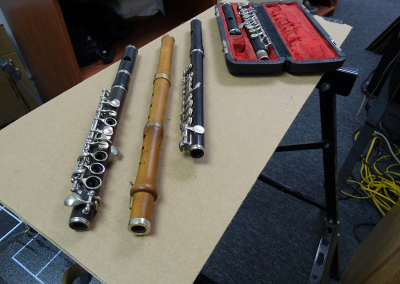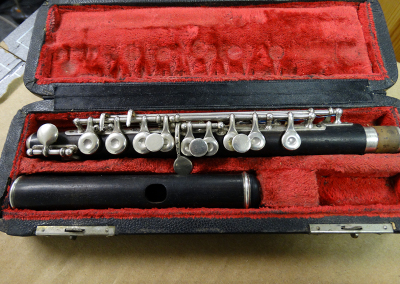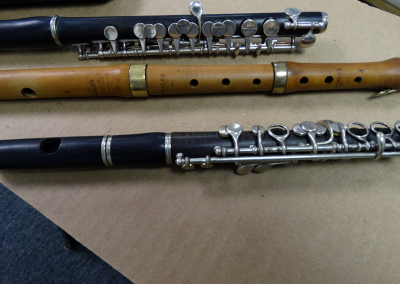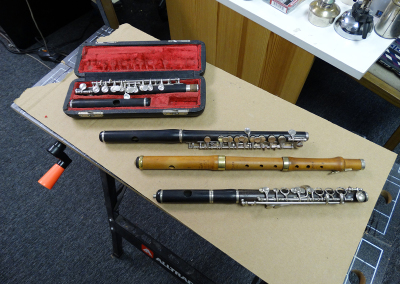THE PICCOLO AND ITS QUALITIES
The early piccolo of the 18th century was a very simple instrument with a cylindrical head joint and a 6 holed conical bored main joint. It was tuned a full octave above the flute of that time. By the 19th century the piccolo had grown to include up to 6 closed hole keys to facilitate the playing of sharps and flats. Often a tuning barrel was added to vary the basic pitch of the piccolo to correspond to pre-tuned instruments. In the mid 19th century Theobald Boehm had developed the modern soprano flute and the piccolo adapted the Boehm keyed fingering system and tone hole spacing.
Even though the Boehm flute and piccolo appear to be identical except for their size and the lack of a C foot joint for the piccolo, there are other more profound differences to be noted.
First of all the modern piccolo is preferentially a wood instrument even though it can and is often fabricated out of metal.
The orchestral piccolo is a full octave above the soprano flute.
The preferred Boehm wood piccolo has a cylindrical head joint and a conical bore body in contrast to the Boehm flute which has a tapered head joint and a cylindrical body.
The metal Boehm piccolo is most often made as a smaller version of the soprano Boehm flute.
The Boehm Piccolo does have upper trill keys and also has a double padded thumb mechanism.
The Boehm Piccolo has and still is produced in several basic keys and they are:
The Key of Eb / Db / C….with C being the most popular.
QUESTIONS OFTEN ASKED ABOUT THE PICCOLO AND ITS REPAIRS:
- Is it possible to repair a cracked head-joint, even if the crack is through the embouchure?
- With modern wood restoring techniques most if not all cracks are repairable and will remain stable into the foreseeable future of the instrument.
- Can the embouchure hole be repaired if chipped or otherwise damaged?
- Is the tenon joint repairable ?
- Most are either repairable or replaceable.
- What is the actual pitch of my Piccolo and can it be altered?
- One way to accurately determine the “real” pitch is to play the Piccolo and observe the pitch on a modern tuning device.
- Physically altering the pitch of the early Piccolo can be achieved by having several head joints of different lengths or changing the tuning barrels position. Moving the cork stopper is not a pitch changing technique but a method of establishing or improving the intonation of the actual pitch of the flutes individual scale notes.
- What are the major wood types used for the early Piccolos?
- In the late eitghteenth century the European Boxwood was a preferred material due to its hardness and lightweight qualities as well as its lustrous golden grain. It was frequently accompanied by body rings made of several fine materials such as elephant ivory and fine ox-bone. By the turn of the nineteenth century, Brazilian rosewood, cocus wood and granadilla supplanted the boxwood as the preferred materials. All three of the above are very dense and don’t suffer from the problem of warping as does boxwood.
- Can the nineteenth century simple system keyed Piccolos be made to play well again.
- By play well if you mean as they were meant to play the answer is an emphatic YES! The keyed simple system Piccolo reached its’ apogee during the nineteenth century and went from a single keyed (D# Key) to a ve six levered instrument as the nineteenth century progressed. If initially well made and cared for these one hundred plus year instruments are both a challenge and delight to play.
- What are the Special characteristics and materials encountered in the above Piccolos.
- Most have head joints that are accompanied by a tuning barrel for pitch adjustment.
- The crown stopper mechanisms are fully adjustable.
- The keys are either block mounted (early nineteenth century) or post mounted with either friction axles or threaded axles.
- The key-work is generally of nickel silver or sterling silver with flat springs mounted on the underside of the key lever and in contact with the body of the flute either directly or with a small metal pad.
- The pads are usually soft kid leather and are floated into place using melted shellac.
- The tenon is either thread wrapped or cork wrapped for an airtight seal.
- Off-time the head joint is completely unlined except for the lower tenon joint but as the Piccolo was called on to project over accompaniment instruments the wood was lined with a metal tube. Wood then began to be replaced with more “resonant” materials such as elephant ivory and metals.
- One of the problems that arose due to the metal linings, was the inability of the overlaying organic material to adjust to the rigidity of the lining which resulted in severe cracks developing longitudinally; off-times through the embouchure.
- I’ve developed specialized techniques to deal with and correct the above problems.
- Do you work on the Boehm Wood Piccolo (Modern Piccolo)?
- Yes I work on all iterations of the Boehm wood Piccolo and they are:
- Early original Boehm open G# with Boehm’s B/Bb key configuration
- Later Boehm with a closed G# Open hole conical bore Boehm Piccolo
- This is a fairly unusual Piccolo and was pioneered by the French.
- Can you alter the pitch of the Piccolo?
- Do you do restoration on the original cases or fabricate cases to fit the restored Piccolo?
- Yes, I both restore the original vintage Piccolo cases and fabricate new fitted cases for any of the Piccolos that need them. My original cases are all constructed from fine stained wood, velvet lined; with brass hardware and are specific to the particular Piccolos they house.
- Yes I work on all iterations of the Boehm wood Piccolo and they are:




